I first spent time with Willy Wang (@wwc.willy) last year during our pop-up shop on Savile Row, when he was here with The Anthology. (He works in the company’s Taipei store, which is also a Bryceland’s retailer.)
I had followed Willy for a while online, and liked the way he played around with clothes, mixing together workwear and tailoring in particular. But it was spending time with him, talking about the clothes themselves, that made me follow more closely.
Willy is very modest, but I think he is one of the best guys around for style and genre combinations. He’s not afraid to experiment, playing with unusual pieces or colours, and often those that are trending in menswear circles – but he also has a strong sense of his own look, and you can see those pieces get worked into his way of dressing, or get discarded and not worn again. He has an open mind, but increasingly a clear identity.
Willy was one of the people that convinced me I could wear more black pieces, more casually – particularly shoes. His combination of Bryceland’s denim shirt and green tweed is the reason I wear mine that way so often.
I’ve been wanting to include Willy in this series on stylish men for a while. I finally got around to it last month, interviewing Willy over email. Below are his answers; I’m sure you will forgive the lack of fluent English.
Permanent Style: Tell us a little about yourself and how you got into clothes
Willy: I started getting into classic menswear when I was 29-30, which is relatively late compared to many out there. Prior to that, I was a software engineer and clothing was simply a hobby.
Like many others, my friends and I started off without any idea of how to dress well, and just mimicked styles. But gradually I developed my own style and started to express it in how I wore the clothes too.
Dressing for me is never a kind of competition with others. It is about conveying your own ideas and identity.
What aspects of clothing, and outfits, do you find most satisfying?
Be it a garment by itself or an outfit as a whole, the most crucial thing for me is that it has to be comfortable and adapted to daily life.
Then it’s about the richness of clothing. My interest is not just classical suiting, but also workwear, utilitarian and even antique clothing. The beautiful story-telling and rich historical context of these clothes gives them not just a superficial beauty, but layers of depth and elegance. It is why I don’t get bored delving into the art of menswear.
How do you decide what to wear each day? What do you start with?
Deciding on what garment to pick is no different to thinking of what to have for a meal: things can be fairly impromptu, and I don’t have a specific component I start with. It can be a bracelet, a pair of shoes or a tie.
A quirk of mine, though, is that I get obsessed with one thing at a time. Once I get the gist of wearing one piece, I tend to have it on me for a prolonged period, trying it out with lots of different looks until all my ideas run out. At that point, I’ll leave it aside and let it sit for a while.
A good example is the light-blue denim/linen jacket I received recently. I’ve tried it with a tie and without, a dark shirt and a light one, and even with just a T-shirt. Moving it through formal to casual.
What mistakes do you think you have made, or lessons learned, in the past?
I would break it down into three stages, and I suppose these are all common for an ever-evolving dresser.
The first stage is wearing strong colours and patterns, or trying very hard to pull off everything in one go – trying to differentiate oneself from the conventional guy.
The second stage is understanding craft – the pitch and balance of a garment – and how it compares to normal clothing. When we have an eye focused on these intricate details, I find most of us follow classic menswear rules quite strictly. Mimicking others is almost inevitable.
The third stage is the best one: returning to the original motive, understanding the bigger picture and not getting too fussy about unnecessary details.
Menswear itself can be a bit of a bubble at times. Adding personal touches and breaking certain rules is the essence of the pursuit of style – when one has a clear idea of their execution. Menswear is at its highest level when the wearer is recognisable even when their face is cropped out of a photo.
The world is an oyster. Every day is a lesson from our mistakes, whether it is in the past or the present. I like doing monthly reviews on my way of dressing, making comparisons with myself a month or half a year ago. By doing that, I realise how my ideas have evolved and moved on from my past self.
You wear quite a lot of black – black shirts, black shoes – in a non-business way. Why do you like that colour, and what do you think it works best with?
Black and white are two of my many favourite colours. And denim is always a good medium between them.
The reason I enjoy the strong use of black and white is that they make me look slimmer (just kidding!) No, black compliments many things – it always has a strong reaction with other colours, brings out one’s maturity in style, and I think balances other things well.
On top of that, when black is worn over time, the creasing and fading of the particular material offer a stronger sense of character, in my opinion, than other colours.
Because black is commonly associated with formalwear, when it is juxtaposed with more casual clothes it leads to unique combinations. I enjoy wearing oxford cloth, linen and moleskin in blacks, for example, mixed with denim.
Amongst all combinations, black loafers, white socks and jeans are my standard ensemble.
I also love dark brown as a colour. In the world of classic menswear, black, white, blue and grey are the most popular colours. Dark brown for me is a good substitute. It has a profound warmness and substance, and comes in a variety of fabrications such as worsted wool, linen, tweed and many more.
This breadth of options allows one to dress in this the colour both formally and casually, without losing any style.
You mix formal and casual clothing together a lot. What advice would you have for others trying to do the same? What would you not mix together?
Start with the basics: wardrobe essentials such as a grey or navy suit, shirt and tie, dark long socks, and oxfords. Then start making small tweaks gradually.
For example, replace a conventional tie with something textured; spice up the look by swapping a normal shirt for a turtleneck sweater, a polo, a rayon/Cuban shirt, or even a t-shirt (when the fit is right); replace your oxfords with a pair of loafers; upgrade your plain weave jacket to hopsack or basketweave, from wool worsted to tweed, cotton and linen.
These are a few of many tiny things one can experiment with. Just take time and slowly gauge what suits your lifestyle. Building a wardrobe is an neverending journey.
Another piece of advice is never blindly follow trends, and what is currently hyped up. These things come and go. With style, it is more important to find pieces that suit your age and identity.
You also wear quite a lot of different headgear – watch caps, baseball caps, berets, panama hats. Which do you think looks best with which other types of clothing?
It all comes from personal experience. A barber I’ve used for years once said, ‘the most stylish person in the room is always the one who knows how to wear a hat, not the one who knows how to do his hair.’ His statement has stayed with me ever since.
I started to integrate more headgear into my clothing a year or two ago. I realised that the use of a fedora or a baseball cap can make an outfit look entirely different. Hats are that powerful.
Panamas and fedoras are ultimately the most stylish choices, and suitable for both formal and casual wear. However, they are a big statement and certainly not for everyone. Baseball caps and watch caps are more versatile and subtle.
How do you cope with heat in Taiwan? What are your favourite clothes for hot weather?
Comfort is crucial, because without comfort a person cannot enjoy his or her garment. Thus, pure linen, cotton/linen shirting, lightweight cotton or our knitted t-shirts are all things I wear often.
Regarding bottoms, open weave trousers such as high-twisted wool, linen or cotton chinos are practical choices. Of course, shorts are also be a sensible choice if one’s working environment allows.
I don’t specify anything on jackets here, simply because wearing a jacket outdoors in our part of the world is rather difficult. However, if one works indoors with good air-conditioning, you can really express yourself.
In Taiwanese summer I wear quite a lot of full linen suits, or shirts with shorts and loafers. I also like to layer a white t-shirt or neat underwear beneath my shirt to balance the strong colours of a shirt, or to create interest through layering.
Talking of layering, roll necks under shirts seems to have become a popular style. What other styles have you adopted recently? Why do you like them?
I always find this an interesting topic. It does seem like when a trend arises, the whole industry raves about it, even if people have their own slightly different interpretations. It’s interesting to watch them come and go.
In terms of other styles, over the years I’ve acquired the habit of mixing denim into tailoring, be it a shirt, a jacket or jeans.
I think the mix of denim and classic menswear (suiting specifically) is one of the coolest yet relatable in a person’s daily life, because most men have at least one pair of jeans sitting around, be they washed or unwashed, straight or slim. It is just the most common and accessible thing in a man’s wardrobe.
Denim is a strong cultural garment, and has evolved for almost two centuries. When worn with tailoring, I think it can be seen as the perfect mix of America’s roots, the elegance of an English gentleman, the carefree attitude of Italians and the thoughtfulness of the Japanese.


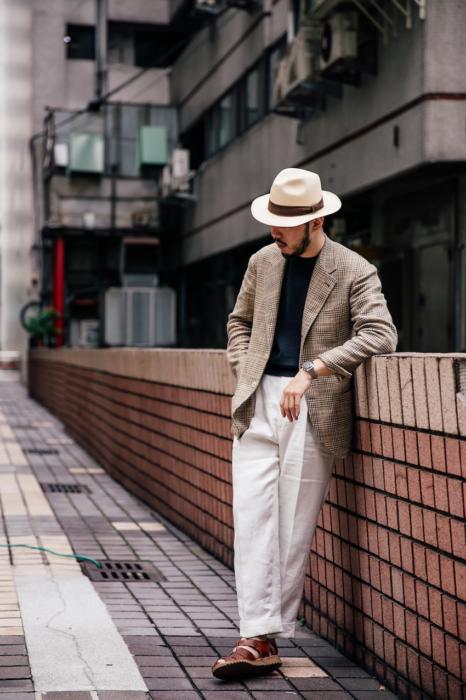
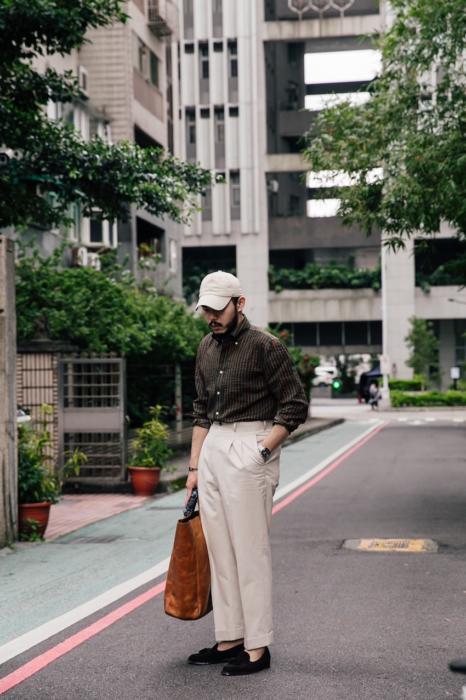
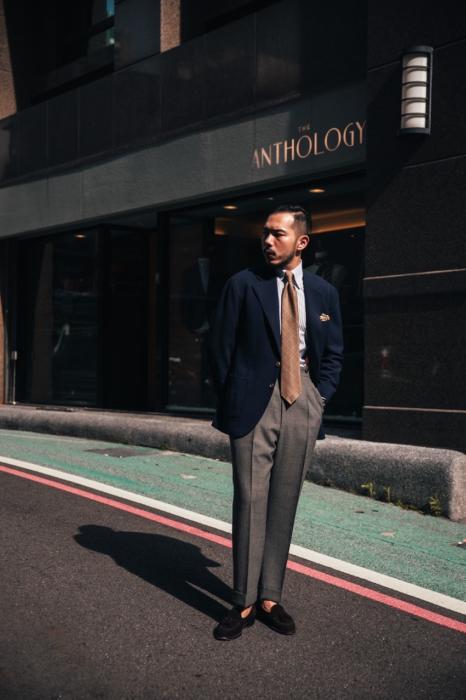
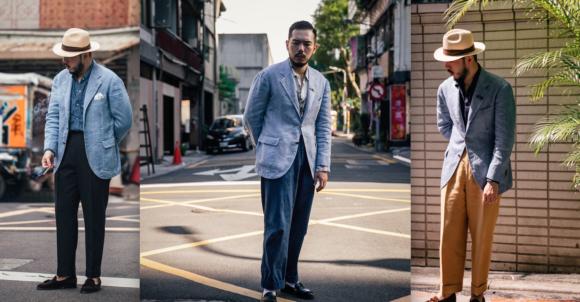
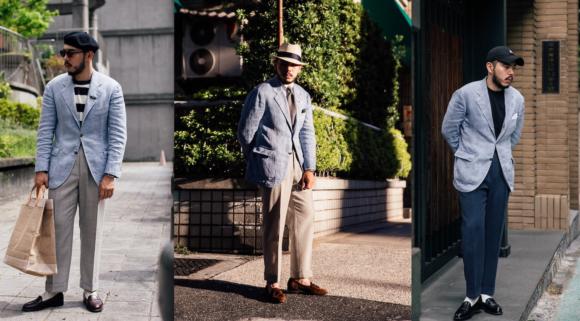
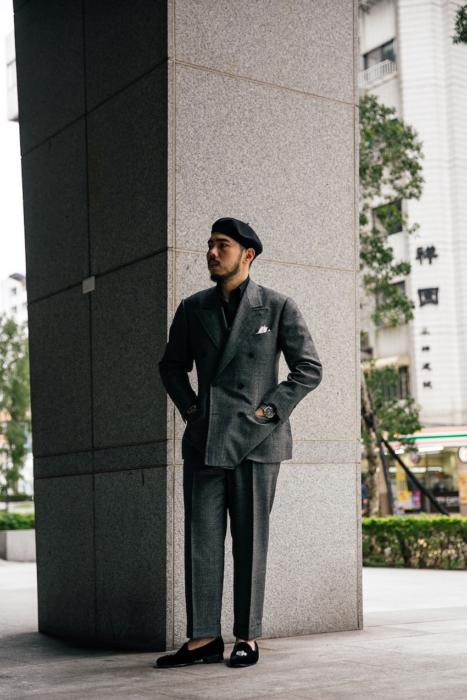
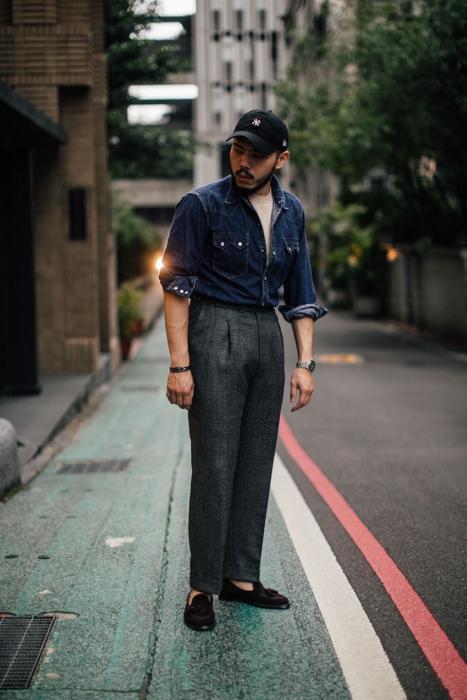
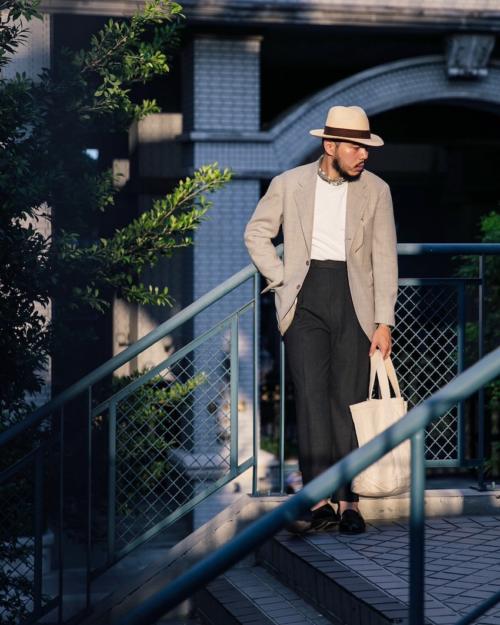
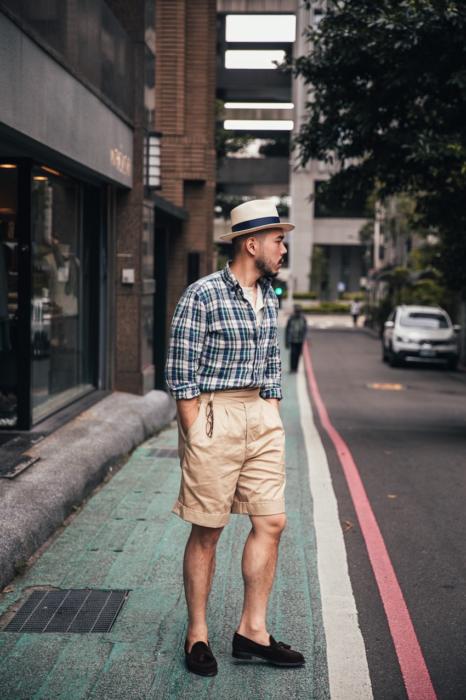
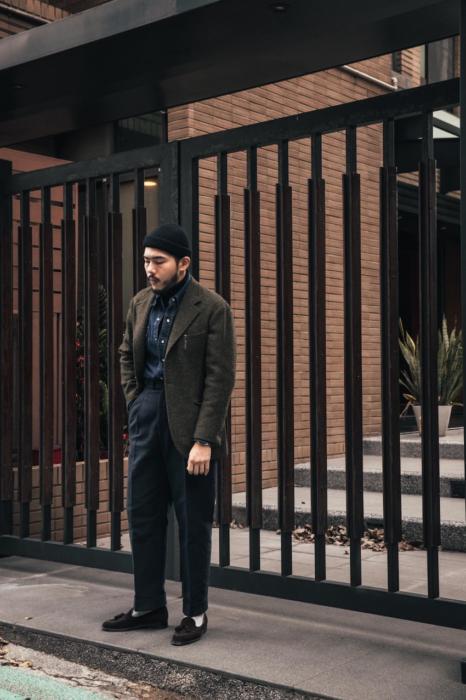
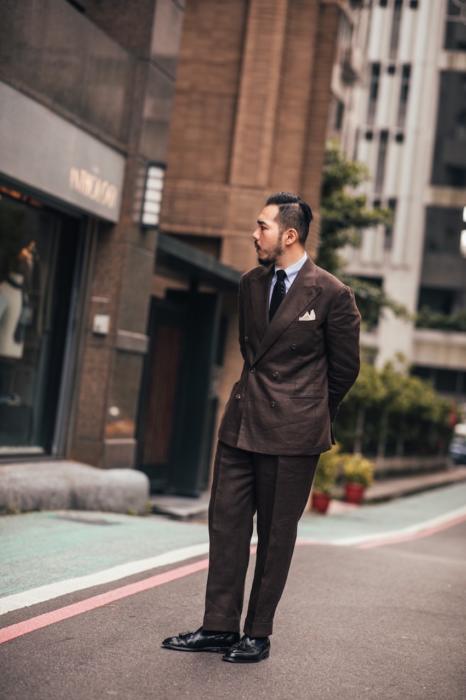


























Simon
Odd question – but you have good taste and are a savvy shopper so thought I would ask having seen on IG. Where did you get the new rug?
I’m no expert on interiors, but I used Rugs of London having had our first one from them a few years ago and it wearing very nicely. Also hand knotted etc.
Do you follow any interiors people? My absolute favourite is Ben Pentreath.
Would be curious to see people from outside of wearables (clothes, jewellery etc) that you really follow
I do follow him too actually, though I really don’t think I’m an expert on interiors or lots of these areas. On most of them I’d rather interview someone else, or have them write I think
I am interested in this. Is it a blog to follow?
Weird but I had the same question… Maybe a one off post on the things you like that aren’t to de with menswear but have the same ethos (i.e. quality, craft longevity) would be interesting?
Sure.
Some great thoughts and an absolutely amazing person!
“Below are his answers; I’m sure you will forgive the lack of fluent English.”
Where was the lacking? He writes fine
He was characteristically modest about his English too
Not trying to pile on or be critical, but that comment really jumped out at me too. Otherwise, I really enjoyed the post, as others in this series.
No worries. I was merely reflecting his hesitancy about his language skills, and expressed hopes that they would be OK
Absolutely agreed on denim. One of my favourite ways to mix things is to wear chinos (or even tailored trousers) with a shirt, waistcoat, and a casual tie, but then to add a denim jacket on top of it. I get special pleasure out of this particular combination, even though some people can’t see the appeal.
This is a great article, thanks Simon. I’ve been admiring Willy’s style for some time. It manages to be both classic and refreshing.
Have you tried/seen the warehouse denim shirts in clutch? How do they compare to the bryceland’s sawtooth?
They’re nice, though not as nice as the Brycelands ones (with the caveat that I haven’t owned and tried the Warehouse)
What a great interview.
Willy Wang is clearly a sartorial Sensi. Two statements in particular summed it all up:
” With style, it is important to find pieces that suit your age and identity”
“Dressing for me is never a kind of competition with others. It is about conveying your own ideas and identity”.
I couldn’t agree more with both and thought he had a great look. That said, I think he needs one of your new bags and he should ditch the embroidered slippers and beret.
Slippers should be for the house only and I’ve yet to meet a flaneur of any description that can pull off the beret without looking like Frank Spencer.
I don’t think most people will know who Frank Spencer is Jason – you’d certainly have to be English, and probably below 50. The interesting thing then is, what do people think of as a reference when they see a beret (worn well, as here)? Given how that comment shows how important such references are for what we think about clothes.
Simon, I’m not ageist and I’m sure there will be some people out there who are over 50 and who know ‘Frank Spencer’ !
Those who don’t are only a google away from meeting him.
The point about the beret is that every 15 years or so, there is an attempt to resurrect them and the truth is, they are just way too effete.
Just as the Stetson should only be worn in cowboy land. The beret should only be worn by peasants en Provence.
Anywhere else and it just looks ridiculous. Willy Wang is a black belt flaneur and when he reflects on these photos he will realise that like the embroidered slippers, it was all just too much.
His other outfits look terrific.
Thank you Jason. I’d suggest you could be a little more open-minded though. Perhaps you don’t intend to, but you seem to dismiss anything you don’t wear out of hand, and often with fairly personal remarks. It’s easy enough to be polite and to say why you think something doesn’t work.
Sir,
I will brook no criticism from yourself with regard to manners.
Perhaps your objective is to stifle opinion that is contrary to yours ?
I was very gracious to Mr. Wang. Indeed I awarded him the coveted status of black belt sartorial Sensi.
However, I’m sure that Willy would be the first to admit that not everything works and that indeed, sometimes sartorial faux pas can be laugh out loud funny. For me carpet slippers and a beret rest in that category.
What I can’t understand is your response that only English people under the age of 50 will know who Frank Spencer is.
Many people over the age of 50 know and love Frank and geographically, he is a world wide phenomenon and perhaps one of the greatest proponents of the beret !
Jason
Isn’t it strange, how every commenter that is criticised thinks it’s because they disagree with a post, despite the fact there are other comments that also disagree, without any issue?
Jason, you said Willy looked ‘ridiculous’, that berets ‘should only be worn by peasants’, and that the stetson should only be worn ‘in cowboy land’. I’m merely suggesting that you could be a little more polite in those points, and whether you also said nice things isn’t really relevant.
With Frank Spencer, as ever you exaggerate. I said I ‘didn’t think’ that ‘most’ people would know the reference, and that you’d ‘probably’ have to be over 50.
Please pause a moment before writing a quick and needlessly emotional reply.
All this talk of Frank Spencer and not one mention of Citizen Smith? What sort of Flaneurs would miss such an obvious cultural touchstone!
Alex – how right you are.
Omitting the good ‘Citizen’ from the debate is unforgivable. Particularly when Willy rocks his look so well in the blue jacket montage!
“…pieces that suit your age and identity”
“It is about conveying your own ideas and identity”
You can’t agree more, yet you said he needs to stop wearing slippers and beret. So in other words yes, but actually no.
I’d also like to point out the casually racist tinged language “Black Belt” “Sensi”. As I’ve never seen Jason use this language before, it’s difficult to see it applied against a gentleman of Asian descent and not wonder about the motivation, however well-intentioned or innocent it was meant to be. In this day and age we must be careful with our language and catch ourselves from falling into poor patterns of thought.
Let us remember that we do not need to be racist to say or have racist thoughts. These small sayings can be incredibly patronizing.
What a complete load of wokist claptrap.
How on earth can the expression ‘Sartorial Black Belt Sensi’ be interpreted as any thing but a compliment ?
Neither ‘Sartorial’ ‘Black Belt’ or ‘Sensi’ denotes any race, creed, religion or colour. Neither does any combination of the aforementioned .
And for the record James, I use this language all the time and will continue to do so unabated. I will however pray that you be released from your poor patterns of thought and join the free world .
Jason, your narrow-mindedness does you no favours. I generally agree with your point of view, yet find myself angered by your reaction. Not to mention the silliness of saying the word ‘sensei’ denotes nothing, despite it being a non-English word specific to only a couple of cultures.
I’m afraid this is an example of what destroys open debate and makes the internet a less interesting and less enjoyable place to be.
Future comments like this will not be published. Here, I thought it was worth highlighting.
Bravo Simon
If we’re getting into the misuse of non-English words, I feel obliged to point out that ‘flâneur’ does not have any sartorial connotations.
Also, it’s nice to have a profile of someone from Taipei, a city of which I am very fond and which I visit regularly. (Or, rather, used to visit until recently.)
Engaging interview, and good choice in highlighting Willy — one of my favorite dressers out there. I like how he’s able to include workwear and other casual elements in a natural manner, in a way that makes you say “interesting” as opposed to “uh wut?” Not easy to do.
Thanks for asking about dressing in hot weather, Simon.
Being in the Southeast U.S. it’s a daily struggle for almost 7 months out of the year.
We do seem to have quite a lot of readers in such climates. I guess a lot of it is ex-pat hotspots, like Hong Kong and Singpore, not to mention Australia
I like that Denim workshirt over roll neck with Tweed jacket over the top! I’d like to incorporate that look as an everyday wear.
It’s a shame if you like clothes and live in a hot and humid climate but it really is quite limiting. I find any form of jacket – linen, unlined, unstructured, whatever – unwelcome from a comfort point of view. Not to mention that if you’ve got sun cream on it’s not worth wearing anything you care about in case it leaves stains. I suppose you could dress up a bit in the air conditioning but still you have to get there and back sweltering all the while. In theory it’s the climate for linen suits but in reality the jacket is too hot to wear plus sweating means constant dry cleaning. I think the lesson in hot climates is lower your expectations of what is possible and buy some nice linen shirts.
The comment regarding black was interesting but it is important to keep in mind that something that looks good on some people does not necessarily work for everyone. I’ve noticed that black is a “look” that works particularly well with Asian men, most likely because they have high contrast features. However, if you have low or medium contrast features (as I do), wearing a lot of black will make you look washed out.
It’s clear from these pictures that Wang has a deep understanding of menswear and thinks about it carefully. His silhouettes are distinct and he throws in so many elements that work coherently together. But his maximalist approach is in some ways the opposite of what I’d consider good style. There are just enough unusual elements in each of these outfits that together they suggest an identity overwhelmed by costume, which may not be altogether misleading considering his occupation. This is no doubt an unfair conclusion considering that the photos here and on his Insta are selected specifically for sartorial interest, but it does speak to a general point: consistent meticulousness may have unintended consequences.
An interesting point, well put. Thanks Ben
Hi Simon
This is a refreshing post on matter of style. On one score, Wang’s understanding of his is worth pondering indeed. That is, when it comes to black shoes.
To me the Black oxfords especially deserves our attention within our current cultural context.
The trend in favor of casual menswear could well end up confining this type of shoes to specific events and outfits (essentially, suits). Therefore, reversing this unsmistakable tide could start by wearing it at least with a navy blazer and grey trousers and a tie. Take a look at this pic (specifically, the third guy from the left) to understand what I mean
https://therake.com/stories/news/the-rake-x-vitale-barberis-canonico-at-pitti-uomo-93/
Isn’t it a lovely look? And yet, the shoes aren’t a dark brown oxfords as we would expect in our current situation of regression. But said outfit is disappearing before our own eyes, friends!
Obviously, he is Italian. But he could have been a Japanese as well. From anywhere else? Frankly, I now doubt!
Yet personally, I wouldn’t stray so far as wearing a black oxfords with a beige chino.
As to the undertaker’s look, as I would call it – the whole black outfit from shoes up to tie, that is – which, the French men now seem to be enamoured with, is utterly beyond my grasp, I musst confess.
John
I think you’re right on the first and latter point John, though I’d also make an argument for a black loafer with the more casual outfits
Yes, it makes sense, Simon.
I think he really looks solid with his headwear. Im envious.
Hey Simon, Can’t believe you’ve chosen a sandal-wearer (first picture)!
Yes I know. That’s one of the reasons I like following Willy – he’s constantly trying out things I wouldn’t wear, but doing it pretty well. That doesn’t mean I would wear the item too, but it often makes me think about it again or in a different way. Indeed, as he says in the piece, that’s what he’s doing a lot of the time, in trying out new things
Simon has an irrational fear of mock-necks and sandals.. 🙂
Well I’d say it was pretty rational! Everything is heavily rationalised, perhaps even too much
For the past few days since you posted this, I’ve been trying to put my finger on what I like so much about the way he dressed. And it’s your point here exactly. His dress is not all rational. But it’s this lack of rationality that really makes him compelling. And honestly a huge education for someone like me who’s still wrapped up in details. It’s uplifting.
Willie is interesting for sure and it’s useful to see some other perspectives. His looks on balance seem more appropriate for fashionistas thus, not particularly useful. One reader commented on the beret look as effete and I must agree. The only people that I’ve seen wear the beret well are the French and may I respectfully suggest that’s where it should stay.
Thanks for the respectful points Scott.
One thing I would say is that any looks can always be considered in parts, rather than the whole, and there’s often more there as a result. You don’t have to like baseball caps, for example, or berets, but can take inspiration from other aspects of the outfits.
Agreed and well said. What parts of Willy’s outfits do you find most interesting for men of conservative dress?
I think there are quite a few, I guess one reason I wanted to include him. I’d suggest looking at:
– The way he wears a panama hat (easily and casually, smaller proportions, hat band colour)
– The way he works black shoes into his outfits (usually loafers, usually with cold colours etc)
– The way he mixes denim with tailoring, in particular denim shirts with tailored trousers, rather than the other way around
– The use of quite dark, sombre colours to prevent outfits becoming too overwhelming.
I’ll study this article with your additional ideas in mind, very helpful. This kind of discussion is one of the many great things about PS, thanks again.
Simon,
Where is the line between that which can be safely adopted as “universal” – like a Panama hat (everyone everywhere can find one that they look good in – or so it seems), and that which may look “affected’ outside its’ home environment (French beret?).
I know it seems personal, and the wearer may be very comfortable, but I can’t help be feel as an observer that something is not “right” – like Europeans in baseball caps…
I think the problem is, it’s entirely cultural and subjective. In different places and cultures, a beret might look fairly natural – but really, that’s just because you see more of them around.
Equally on baseball caps, I think they are ubiquitous enough now that I don’t think it matters if someone is European.
Agreed on the ubiquity of the baseball cap, it really is worldwide. Mind you, that doesn’t mean that I think it’s a good look, but it doesn’t look odd whether worn by the Japanese or the Brits. The beret has a different position in my view. I’ve seen it on people all my life so, it’s not unusual. However, I find that the beret simply looks effete and awkward on most men who are not French and I don’t know why. Of course this is subjective, but this observation has been made by other PS readers. Interestingly, women, regardless of country, wear the beret very well. What is about the beret?
Glad to see this series get an update.
I remain optimistic we’ll see Tommaso Capozzoli added with loads of pictures.
A little off topic question but as Willy is with Anthology I thought here made sense.
I see lots of mentions of great clothing on this site from places like Anthology, The Armoury, Brycelands, all of which are based abroad. I’d be interested to hear how others go on purchasing from these and similar stores abroad, given how difficult it is to predict sizing and fit. Are people making purchases and sending a lot of them back, and just considering the cost of the postage a worthwhile risk?
Being slightly short I often find that I have to return clothes purchase online as they don’t fit well. I’d love to order from some of the above brands but suspect I’ll end up frequently just shelling out for return postage. I just wondered if I’m missing a trick somehow.
One thing I’m surprised people don’t do more, is measure their own clothes and compare them to the measurements a brand puts online. It’s so much more accurate that going off your own body measurements, because people like things to fit in so many different ways.
I find that makes quite a big difference. Also, a lot of brands are happy for you to buy two sizes and return one, with free returns. I feel that’s a fair exchange when someone doesn’t have a physical shop in particular.
Some great thoughts also available on https://expertwatchman.com/ and an absolutely amazing person!
This guy seems to have a knack for hitting on most of the things I don’t like around dressing.
Out of curiosity when meeting readers or meet consultancy clients, do they share similar taste/dress to you? Or is it a wide spectrum of more casual or formal?
It’s not normally that diverse, otherwise they probably wouldn’t ask for the advice. There are people who wear a suit most days to work, and others that never do. But they’re all interested in being better put together and probably smarter, involving some form of tailoring usually.
Great interview, I have agree on black loafer (mine was tassel), I end up using it in a “non traditional” sense more so than I thought I would. Now what I would be interested is if someone can work say a smooth calf black oxford into a casual outfit
Thank you Simon for introducing Willy to us. I notice myself preferring to wear dark colors and a blend of causal-wear with tailored-wear, so I’m most drawn to the penultimate photo of Willy.
I’m looking for more inspiration and reference photos for dark colored outfits, and I recall you writing an article about your shift to darker colored outfits on Permanent Style. Could you provide a link to that article, if you know what I’m talking about? By the way, on your instagram, do you use a special tag for your outfits that fall in this category? I find those are some of the outfits that look the best on you, but my personal biases are likely showing.
Sure, I think you’re referring to this one?
https://www.permanentstyle.com/2020/01/wearing-black.html
Looking back, this article must have been my first introduction to Willy, but it was only later, in a post of his from the Anthology on Instagram, that I was prompted to follow him there. And now I look forward to his outfit shots as much as I look forward to PS articles! A real modern icon. Thanks a lot to you both, Simon and Willy
does this guy have an instagram ?
yes – it’s linked in the article